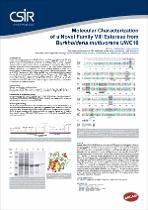 ResearchSpace
ResearchSpace
Molecular characterization of a novel family VIII esterase from burkholderia multivorans UWC10
JavaScript is disabled for your browser. Some features of this site may not work without it.
- ResearchSpace
- →
- Research Publications/Outputs
- →
- Conference Publications
- →
- View Item
| dc.contributor.author |
Rashamuse, KJ

|
|
| dc.contributor.author |
Burton, SG

|
|
| dc.contributor.author |
Stanfford, WHL

|
|
| dc.contributor.author |
Cowan, DA

|
|
| dc.date.accessioned | 2009-05-13T09:36:42Z | |
| dc.date.available | 2009-05-13T09:36:42Z | |
| dc.date.issued | 2007-02 | |
| dc.identifier.citation | Rashamuse, KJ, Burton, SG, Stanfford, WHL and Cowan, DA. 2006. Molecular characterization of a novel family VIII esterase from burkholderia multivorans UWC10. 20th South African society of biochemistry and molecular biology, University of Natal, Pietermarizburg, January 2006, pp 1 | en |
| dc.identifier.uri | http://hdl.handle.net/10204/3376 | |
| dc.description | 20th South African society of biochemistry and molecular biology, University of Natal, Pietermarizburg, January 2006 | en |
| dc.description.abstract | An esterase producing Burkholderia multivorans UWC10 strain was isolated by culture enrichment. A shotgun library of B. multivorans UWC10 genomic DNA was screened for esterase activity and a recombinant clone conferring an esterolytic phenotype was identified. Full-length sequencing of the DNA insert showed that it consisted of a single open reading frame (ORF1) encoding a predicted protein of 398 amino acids. ORF1 (termed EstBL) had a high protein sequence identity to family VIII esterases. The EstBL primary structure showed two putative serine motifs, G-V-S149-D-G and S74-V-T-K. The estBL gene was successfully over-expressed in E. coli and the encoded protein purified by a combination of ammonium sulphate fractionation, hydrophobic interaction, ion exchange and size exclusion chromatographies. Biochemical assays confirmed EstBL esterase activity and revealed a preference for short-chain p-nitrophenyl and beta-naphthyl esters (C2-C4) with no activity against beta-lactam substrates. Secondary structure predictions indicated that EstBL adopts the alpha/beta fold, which is common to all esterases | en |
| dc.language.iso | en | en |
| dc.subject | Molecular characterization | en |
| dc.subject | Family III esterase | en |
| dc.subject | Burkholderia multivorans | en |
| dc.subject | UWC10 | en |
| dc.subject | Penicillin | en |
| dc.subject | Enzymes | en |
| dc.subject | Carboxylesterases gene | en |
| dc.subject | 3D model structur | en |
| dc.subject | DNA | en |
| dc.title | Molecular characterization of a novel family VIII esterase from burkholderia multivorans UWC10 | en |
| dc.type | Conference Presentation | en |
| dc.identifier.apacitation | Rashamuse, K., Burton, S., Stanfford, W., & Cowan, D. (2007). Molecular characterization of a novel family VIII esterase from burkholderia multivorans UWC10. http://hdl.handle.net/10204/3376 | en_ZA |
| dc.identifier.chicagocitation | Rashamuse, KJ, SG Burton, WHL Stanfford, and DA Cowan. "Molecular characterization of a novel family VIII esterase from burkholderia multivorans UWC10." (2007): http://hdl.handle.net/10204/3376 | en_ZA |
| dc.identifier.vancouvercitation | Rashamuse K, Burton S, Stanfford W, Cowan D, Molecular characterization of a novel family VIII esterase from burkholderia multivorans UWC10; 2007. http://hdl.handle.net/10204/3376 . | en_ZA |
| dc.identifier.ris | TY - Conference Presentation AU - Rashamuse, KJ AU - Burton, SG AU - Stanfford, WHL AU - Cowan, DA AB - An esterase producing Burkholderia multivorans UWC10 strain was isolated by culture enrichment. A shotgun library of B. multivorans UWC10 genomic DNA was screened for esterase activity and a recombinant clone conferring an esterolytic phenotype was identified. Full-length sequencing of the DNA insert showed that it consisted of a single open reading frame (ORF1) encoding a predicted protein of 398 amino acids. ORF1 (termed EstBL) had a high protein sequence identity to family VIII esterases. The EstBL primary structure showed two putative serine motifs, G-V-S149-D-G and S74-V-T-K. The estBL gene was successfully over-expressed in E. coli and the encoded protein purified by a combination of ammonium sulphate fractionation, hydrophobic interaction, ion exchange and size exclusion chromatographies. Biochemical assays confirmed EstBL esterase activity and revealed a preference for short-chain p-nitrophenyl and beta-naphthyl esters (C2-C4) with no activity against beta-lactam substrates. Secondary structure predictions indicated that EstBL adopts the alpha/beta fold, which is common to all esterases DA - 2007-02 DB - ResearchSpace DP - CSIR KW - Molecular characterization KW - Family III esterase KW - Burkholderia multivorans KW - UWC10 KW - Penicillin KW - Enzymes KW - Carboxylesterases gene KW - 3D model structur KW - DNA LK - https://researchspace.csir.co.za PY - 2007 T1 - Molecular characterization of a novel family VIII esterase from burkholderia multivorans UWC10 TI - Molecular characterization of a novel family VIII esterase from burkholderia multivorans UWC10 UR - http://hdl.handle.net/10204/3376 ER - | en_ZA |





